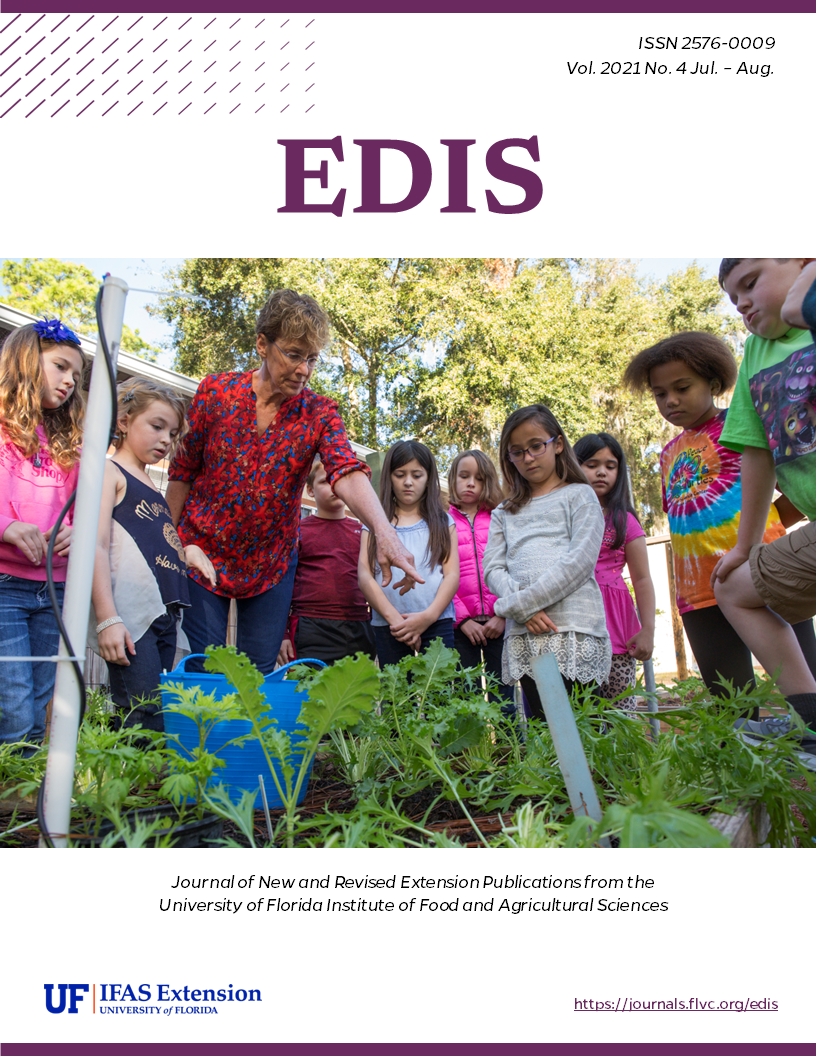Resumen
Pepper stip (meaning speck in German), also referred to as color speck or colour spotting outside the US, is considered a physiological disorder of pepper. The disorder is believed to be related to high calcium status with levels of NH3-N and K playing a role. This 3-page factsheet of the UF/IFAS Plant Pathology Department summarizes known symptoms, causes, and potential environmental stressors that may result in stip development on peppers. Written by Camille McAvoy and Pamela Roberts.
Citas
Aloni, B., L. Karni, I. Rylski, and Z. Zaidman. 1994. “The Effect of Nitrogen Fertilization and Shading on the Incidence of ’Colour Spots‘ in Sweet Pepper (Capsicum annuum) Fruit.” J. Hort. Sci. 69 (4): 767–773. https://doi.org/10.1080/14620316.1994.11516511
Bosland, P. W., and E. J. Votava. 2000. Peppers: Vegetable and Spice Capsicums. Crop Production Science in Horticulture Series (Vol. 12). Oxon, UK: CABI Publishing.
Cheewawiriyakul, S., R. Chiang, K. Conn, B. Gabor, J. Kao, and R. Salati. 2006. Pepper and Eggplant Disease Guide: A Practical Guide for Seedmen, Growers, and Agricultural Advisors. Kevin Conn (Ed.). Woodland, CA: Seminis. https://santamariaseeds.com/wp-content/uploads/2016/10/Pepper_Eggplant_Disease_Guide.pdf
Eijsinga, R. R. Rodenburg, and L.G. Uffelen. 1973. “Bitter Pit, a New Quality Problem in Red Peppers.” Bedrijfsontwikkeling 4 (7/8): 733–734.
Fulton, J. C. 2016. “Chile Pepper Stip: A Physiological Disorder of Peppers.” M.S. Thesis. University of New Mexico.
Fulton, J. C., F. O. Holguin, R. L. Steiner, and M. E. Uchanski. 2021. “A Microscopic and Metabolic Description of Stip-Affected Tissue in New Mexico Pod-Type Pepper.” J. Amer. Hort. Sci. 146 (3): 169–177. https://doi.org/10.21273/JASHS05004-20
Fulton, J. C., and M. E. Uchanski. 2017. “A Review of Chile Pepper (Capsicum annuum) Stip: A Physiological Disorder of Peppers.” HortSci 52 (1): 4–9. https://doi.org/10.21273/HORTSCI11123-16
Hartz, T., M. Cantwell, and M. Lestrange. 2008. Bell Pepper Production in California. Publication 7217. University of California, Division of Agriculture and Natural Resources. https://doi.org/10.3733/ucanr.7217
Johnson, G. 2012. “Stip Disorder in Peppers.” Weekly Crop Update. University of Delaware Cooperative Extension. https://sites.udel.edu/weeklycropupdate/?p=4780
Jovicich, E., D. J. Cantliffe, P. J. Stoffella, and D. Z. Haman. 2007. “Bell Pepper Fruit Yield and Quality as Influenced by Solar Radiation-Based Irrigation and Container Media in a Passively Ventilated Greenhouse.” HortSci. 42 (3): 642–652. https://doi.org/10.21273/HORTSCI.42.3.642
Ontario Ministry of Agriculture, Food and Rural Affairs (OMAFRA). 2009. “Colour Disorders.” In Ontario Crop IPM. Queen’s Printer for Ontario. http://www.omafra.gov.on.ca/IPM/english/peppers/diseases-and-disorders/colour-disorders.html
Savvas, D., G. Ntatsi, and H. C. Passam. 2008. “Plant Nutrition and Physiological Disorders in Greenhouse Grown Tomato, Pepper, and Eggplant.” Euro. J. Plant Sci Biotech. 2 (SI 1): 45–61.
Seminis. 2017. “Agronomic Spotlight: Pepper Stip.” https://www.seminis-us.com/resources/agronomic-spotlights/pepper-stip/
Silber, A., A. Bar-Tal, I. Levokvitch., M. Bruner, H. Yehezkel, D. Shmuel, S. Cohen. E. Matan, L. Karni, H. Aktas, E. Turhan, and B. Aloni. 2009. “Manganese Nutrition of Pepper (Capsicum annuum L.): Growth, Mn Uptake, and Fruit Disorder Incidence.” Scientia Hort. 123:197–203. https://doi.org/10.1016/j.scienta.2009.08.005
Smith, R., R. Mullen, and T Hartz. 1999. “Epidemiology and Control of Pepper Stip.” HortSci. 34 (3): 441. https://doi.org/10.21273/HORTSCI.34.3.

